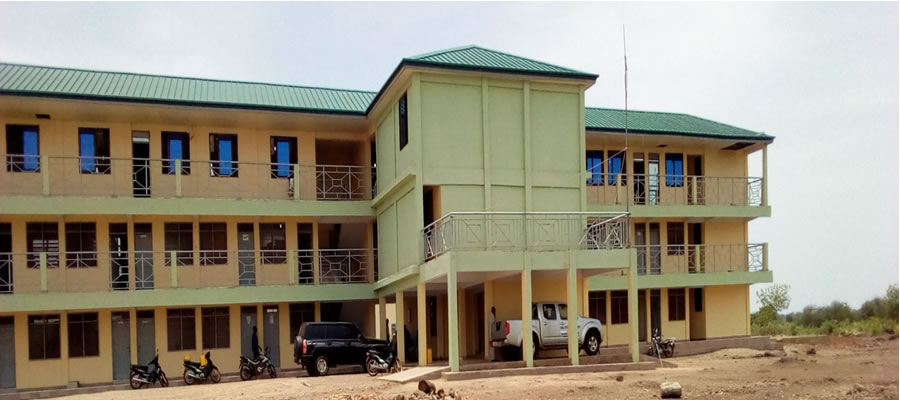

Introduction
This chapter focuses on analysis of data on household structure, size and composition in the Lambussie-Karni District. The 2010 Population and Housing Census (PHC) defines household as a person or a group of persons who live together in the same house or compound, share the same house-keeping arrangement and are catered for as one unit (Ghana Statistical Service, 2010). Households are reflections of the social structure, in that living arrangements are largely influenced by such socio-cultural factors as marriage, and the types of family and kinship systems in the society.
Household Size, Household Population, Composition and Headship
Household population provides important information to policy makers and planners with regard to resource allocation for social services such as shelter, health and education. A household normally consists of a head, with or without spouse, children, in-laws, parents, grandchildren, and other relatives.
Household size
Table 3.1 shows that, the average household size for the district is 6.8 as compared to the region which is 6.2. This shows that, there is no much difference between the district and the region. The average household size is higher for rural areas than urban areas (7.0 and 5.7 respectively). The Table further reveals that, the average household per house for the district is 1.3 and this is higher for rural areas compared to urban areas.
Household composition
Table 3.2 depicts the household composition of the Lambussie-Karni District by sex. The total household population in the district is 50,896 of which (24,517) 48.2 percent are males and (26379) 51.8 percent females. The number of household heads is 7,524 out of which 72.6 percent are male and 27.7 percent are females.
Children of the head of household constitute the majority (43.6%) of the household population and the heads of household and other relatives constitutes 14.8 percent and 10.8 percent respectively). There are more sons (50.3%) compared to daughters (37.3%) in the household. The proportion of grandchildren in household in the district is 8.7 percent compared to 10.8 percent of other relatives. Within the male household population, other relatives account for 5.9 percent while that in the female household population accounts for 15.4 percent.
This pattern of household composition supports the view that the traditional household structure remains pervasive in the district. The proportion of non-relatives, step-children, and adopted/foster children is low, representing 0.5 percent, 1.9 percent and 0.3 percent respectively.
Household structure
Household structure is defined as classification of ties of affiliations of persons who constitute households. Table 3.3 shows the distribution of household population by structure by sex in the Lambussie-Karni District. The extended family (head, spouse(s), children and head's relatives) have the highest proportion with 53.6 percent while the nuclear (head, spouse(s) and children) accounts for 17.4 percent, with single parent extended family system accounting for 12.2 percent of the household structure. This reveals that, the household structure in the district is largely the extended family system.
In terms of the male and female members of households, structures within the district indicate that, the extended (head, spouse(s), children and head's relatives) is made up of 53.6 percent male and 53.7 percent female. Nuclear (head, spouse(s) and children) constitutes 19.2 percent of the males compared to 15.8 percent of the females. The single parent extended household is slightly more (13.1%) in the female household members compared with the same category in the male household members (11.2%).
INFORMATION COMMUNICATION TECHNOLOGY
Introduction
Communication serves as an important tool in the economic and social lives of people. Businesses are transacted through communication, and the availability of effective and reliable communication channels can enhance economic activity and improve incomes. Recent developments in communication include the use of mobile phones, desktop or laptop computers and the internet.
Ownership of Mobile Phones
Table 5.1 shows the population 12 years and older by ownership of mobile phone, internet facility usage and sex. An examination of the distribution of mobile phone ownership in the district indicates that, there are more males than females owning mobile phones. Out of the a population of 33,371 who are 12 years and older in the district, only 19.4 percent have mobile phones,
Among the male population only 28.3 percent own mobile phones. Similarly among the females the situation is gloomier with only 11.9 percent of the females having mobile phones in the district,
Use of Internet
Table 5.1, further shows the use of internet by population 12 years and older. It indicates that about 0.8 percent of the population 12 years and older in the district are using internet facility. A higher proportion of the male population (1.2%) are using internet facility than their female counterparts (0.4%).
Household Ownership of Desktop or Laptop Computers
Households in the Lambussie-Karni District that own a desktop or laptop computer are only 2.4 percent of the total households as indicated in Table 5.2. In addition only 3.0 percent and 1.0 percent of the male and female headed households respectively in the district, have desktop/laptops. This low and seriously insignificant ownership of ICT equipment i.e. mobile phones, computers and internet usage have serious implication for the development of the district.
Date Created : 4/10/2018 7:24:11 AM










 facebook
facebook
 twitter
twitter
 Youtube
Youtube
 +233 593 831 280
+233 593 831 280 0800 430 430
0800 430 430 GPS: GE-231-4383
GPS: GE-231-4383 info@ghanadistricts.com
info@ghanadistricts.com Box GP1044, Accra, Ghana
Box GP1044, Accra, Ghana